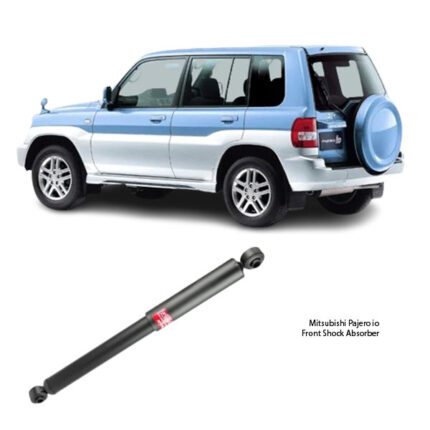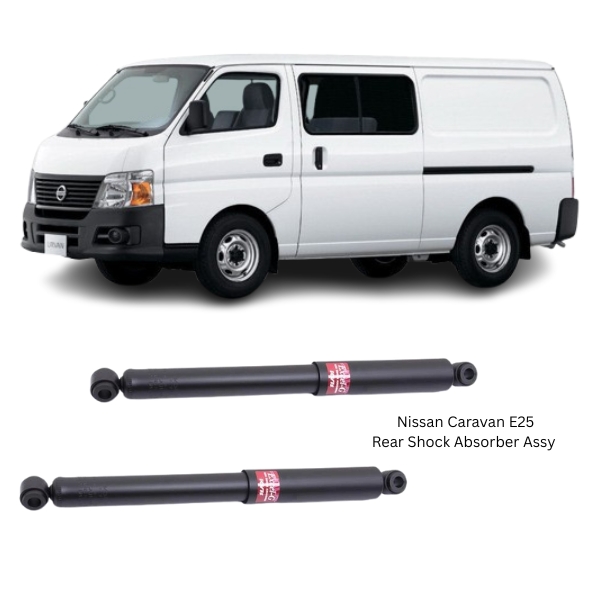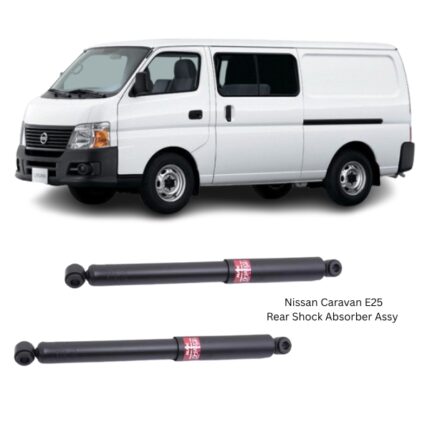Get Nissan Caravan E25 Rear Shock Absorber Assy 343425 in Kenya
The Rear Shock Absorber Assembly is a critical suspension component responsible for enhancing ride comfort, improving vehicle handling, and ensuring optimal tire-to-road contact. It plays an essential role in both everyday driving and demanding road conditions by managing the vertical motion of the vehicle’s rear suspension system. By absorbing and dissipating kinetic energy, the shock absorber maintains chassis stability, prolongs the lifespan of related components, and offers a consistently smooth ride.
Purpose and Function
The core function of the rear shock absorber assembly is to control suspension movement. Without a shock absorber in place, a vehicle would bounce excessively after hitting bumps or potholes. This component helps to:
-
Dampen Spring Oscillations: The shock absorber regulates the up-and-down movement of the coil or leaf springs, preventing continuous bouncing.
-
Improve Road Grip: By minimizing wheel lift after an impact, it ensures the tires remain in contact with the road, which is critical for safe braking, acceleration, and steering.
-
Stabilize the Rear End: During acceleration, cornering, or heavy braking, the shock absorber reduces body roll, squat, and sway, contributing to improved overall vehicle control.
-
Enhance Passenger Comfort: It cushions the impact of uneven surfaces, reducing vibrations and jolts transferred to the vehicle’s interior.
Design and Construction
The rear shock absorber assembly is a self-contained mechanical-hydraulic unit made from high-strength materials and engineered to endure intense operational conditions. Its primary components include:
1. Outer Tube (Reservoir)
The outer casing is made of corrosion-resistant steel or aluminum alloy, designed to house the internal mechanism and withstand environmental exposure. It protects internal components from moisture, road debris, and corrosion.
2. Working Tube
Inside the reservoir is the working chamber, where a piston and hydraulic fluid operate to provide damping. The precision-machined inner surface ensures smooth piston movement and minimal internal wear.
3. Piston and Valve System
The piston is connected to a rod and fitted with a series of small valves that control the flow of hydraulic fluid. When the piston moves due to suspension compression or rebound, fluid passes through the valves, generating resistance and creating a damping effect.
4. Hydraulic Fluid
A specialized oil is used to fill the working chamber. This fluid is formulated to resist thermal degradation, foaming, and viscosity breakdown across varying temperatures and operating conditions. It converts the kinetic energy of suspension movement into heat, which is then dissipated through the shock body.
5. Gas Charge (Optional)
Many modern rear shock absorbers are gas-pressurized, containing a chamber filled with nitrogen. The gas prevents fluid aeration and cavitation under rapid movements, ensuring consistent damping and improved responsiveness.
6. Rod and Seal Pack
The piston rod, typically hard-chromed for durability, extends through a series of seals and bushings at the top of the unit. These seals prevent fluid leakage while keeping contaminants out, contributing to the unit’s longevity.
7. Mounting Points
The top and bottom ends of the shock absorber feature mounting eyelets or studs with integrated rubber bushings. These components absorb minor vibrations and facilitate secure, flexible attachment to the vehicle’s suspension and frame.
Performance Characteristics
The rear shock absorber assembly is engineered to maintain consistent performance under various load conditions and road surfaces. Key performance traits include:
-
Progressive Damping: Provides soft response on minor bumps while stiffening under heavy compression, ensuring balanced comfort and control.
-
Fade Resistance: Maintains effective damping even under continuous, rapid cycling (e.g., rough terrain), thanks to heat-dissipating construction and high-quality fluid.
-
Noise and Vibration Control: Reduces transmission of harshness and road noise to the cabin, enhancing driver and passenger comfort.
-
Load Adaptation: Supports varying cargo and passenger loads by adjusting its damping behavior, helping to maintain ride height and handling balance.
Types of Rear Shock Absorbers
Several variations of rear shock absorber assemblies are available, each designed to meet different vehicle requirements and usage conditions:
-
Twin-Tube Hydraulic: Utilizes two concentric cylinders with hydraulic fluid to provide basic damping. Ideal for standard driving conditions.
-
Twin-Tube Gas-Charged: Similar to the hydraulic version, but includes nitrogen gas to improve response and reduce fade.
-
Monotube: Features a single large cylinder with separate oil and gas chambers, providing superior heat dissipation and damping control.
-
Coilover Shock: Combines the shock absorber with a coiled spring wrapped around the body, offering integrated support and adjustable height options.
-
Load-Leveling or Air-Assisted: Includes auxiliary air chambers or self-leveling mechanisms to maintain ride height under varying loads.
Durability and Materials
High-quality rear shock absorber assemblies are built using premium-grade materials to withstand frequent movement, high temperatures, and challenging environments. Common material features include:
-
Heat-Treated Steel Rods: Resistant to bending and corrosion.
-
Powder-Coated or Zinc-Plated Bodies: Offer extra protection against rust and moisture.
-
Multi-Lip Seals: Engineered to retain hydraulic fluid and exclude contaminants.
-
High-Density Rubber Bushings: Reduce road noise and cushion mounting vibrations.
Manufacturing processes involve CNC-machining, robotic welding, and rigorous testing protocols to ensure dimensional accuracy and performance reliability.
Installation and Maintenance
Replacing the rear shock absorber assembly typically requires lifting the vehicle and unbolting the upper and lower mounts. Proper installation ensures that the unit performs to its full potential. It’s advisable to replace both rear shock absorbers simultaneously to maintain symmetrical performance.
Inspection and replacement intervals depend on usage but should be considered every 60,000 to 100,000 kilometers, or sooner if the following signs appear:
-
Excessive bouncing after bumps
-
Fluid leaks around the shock body
-
Noticeable knocking or clunking sounds
-
Uneven or accelerated rear tire wear
-
Poor handling, especially while cornering or braking
Routine visual checks can identify leaks, worn bushings, or physical damage, all of which indicate the need for replacement.
Safety and Comfort Impacts
A properly functioning rear shock absorber assembly greatly influences the vehicle’s dynamics and occupant experience. The component enhances:
-
Braking Efficiency: Prevents rear-end lift and maximizes rear tire grip.
-
Steering Response: Helps stabilize the vehicle during directional changes.
-
Load Carrying Stability: Maintains composure even when cargo weight shifts.
-
Driver Confidence: Provides a predictable and secure driving experience.
Follow us on Facebook for more parts.




